Effect of Deforestation on Land Surface Temperature in the Chiquitania Region, Bolivia
Abstract
1. Introduction
2. Materials and Methods
2.1. Study Area
2.2. Data Sources
2.3. Sampling Sites and Data Processing
2.4. Statistical Analysis
3. Results
3.1. Temporal Dynamics of Land Cover Type
3.2. Annual Trends of Forest Cover Loss in the Chiquitania Region
3.3. Annual Trends in Land Surface Temperature (LST) Day and Night (°C) in Forested and Deforested Areas
3.3.1. Annual Averages of Daytime LST
3.3.2. Annual Trends of Daytime LST
3.3.3. Annual Averages of Nighttime LST
3.3.4. Annual Trends of Nighttime LST
3.4. Relationship between Intact Forest and Areas with Deforestation Processes and Daytime and Nighttime LST (°C)
3.5. Validation Using In Situ Measurement
4. Discussion
5. Conclusions
Author Contributions
Funding
Data Availability Statement
Acknowledgments
Conflicts of Interest
References
- Siyum, Z.G. Tropical dry forest dynamics in the context of climate change: Syntheses of drivers, gaps, and management perspectives. Ecol. Process. 2020, 9, 1–16. [Google Scholar] [CrossRef]
- Pokorný, J.; Brom, J.; Cermák, J.; Hesslerová, P. Solar energy dissipation and temperature control by water and plants. Int. J. Water 2010, 5, 311–336. [Google Scholar] [CrossRef]
- Li, Y.; Zhao, M.; Mote, S.; Mu, Q.; Kalnay, E.; Li, S. Local cooling and warming effects of forests based on satellite observations. Nat. Commun. 2015, 6, 6603. [Google Scholar] [CrossRef] [PubMed]
- Chen, L.; Dirmeyer, P.A. Reconciling the disagreement between observed and simulated temperature responses to deforestation. Nat. Commun. 2020, 11, 1–10. [Google Scholar] [CrossRef] [PubMed]
- Bonan, G.B. Forests and climate change: Forcings, feedbacks, and the climate benefits of forests. Science 2008, 320, 1444–1449. [Google Scholar] [CrossRef]
- Foley, J.A.; DeFries, R.; Asner, G.P.; Barford, C.; Bonan, G.; Carpenter, S.R.; Chapin, F.S.; Coe, M.T.; Daily, G.C.; Gibbs, H.K.; et al. Global consequences of land use. Science 2005, 309, 570–574. [Google Scholar] [CrossRef]
- Lawrence, D.; Vandecar, K. Effects of tropical deforestation on climate and agriculture. Nat. Clim. Chang. 2014, 5, 27–36. [Google Scholar] [CrossRef]
- Mildrexler, D.J.; Zhao, M.; Cohen, W.B.; Running, S.W.; Song, X.P.; Jones, M.O. Thermal Anomalies Detect Critical Global Land Surface Changes. J. Appl. Meteorol. Clim. 2018, 57, 391–411. [Google Scholar] [CrossRef]
- Feddema, J.J.; Oleson, K.W.; Bonan, G.B.; Mearns, L.O.; Buja, L.E.; Meehl, G.A.; Washington, W.M. The Importance of Land-Cover Change in Simulating Future Climates. Science 2005, 310, 1674–1678. [Google Scholar] [CrossRef]
- Baker, J.C.A.; Spracklen, D.V. Climate Benefits of Intact Amazon Forests and the Biophysical Consequences of Disturbance. Front. For. Glob. Chang. 2019, 2, 47. [Google Scholar] [CrossRef]
- Schultz, N.M.; Lawrence, P.J.; Lee, X. Global satellite data highlights the diurnal asymmetry of the surface temperature response to deforestation. J. Geophys. Res. Biogeosci. 2017, 122, 903–917. [Google Scholar] [CrossRef]
- Chapman, S.; Watson, J.E.M.; Salazar, A.; Thatcher, M.; McAlpine, C.A. The impact of urbanization and climate change on urban temperatures: A systematic review. Landsc. Ecol. 2017, 32, 1921–1935. [Google Scholar] [CrossRef]
- Song, X.-P.; Hansen, M.C.; Stehman, S.V.; Potapov, P.V.; Tyukavina, A.; Vermote, E.F.; Townshend, J.R. Global land change from 1982 to 2016. Nature 2018, 560, 639–643. [Google Scholar] [CrossRef]
- Curtis, P.G.; Slay, C.M.; Harris, N.L.; Tyukavina, A.; Hansen, M.C. Classifying drivers of global forest loss. Science 2018, 361, 1108–1111. [Google Scholar] [CrossRef]
- Zalles, V.; Hansen, M.C.; Potapov, P.V.; Parker, D.; Stehman, S.V.; Pickens, A.H.; Parente, L.L.; Ferreira, L.G.; Song, X.-P.; Hernandez-Serna, A.; et al. Rapid expansion of human impact on natural land in South America since 1985. Sci. Adv. 2021, 7, eabg1620. [Google Scholar] [CrossRef]
- Potapov, P.; Hansen, M.C.; Pickens, A.; Hernandez-Serna, A.; Tyukavina, A.; Turubanova, S.; Zalles, V.; Li, X.; Khan, A.; Stolle, F.; et al. The Global 2000–2020 Land Cover and Land Use Change Dataset Derived From the Landsat Archive: First Results. Front. Remote. Sens. 2022, 3, 856903. [Google Scholar] [CrossRef]
- Buchadas, A.; Baumann, M.; Meyfroidt, P.; Kuemmerle, T. Uncovering major types of deforestation frontiers across the world’s tropical dry woodlands. Nat. Sustain. 2022, 5, 619–627. [Google Scholar] [CrossRef]
- Müller, R.; Pacheco, P.; Montero, J.C. The Context of Deforestation and Forest Degradation in Bolivia: Drivers, Agents and Institutions; Occasional Paper 108; CIFOR: Bogor, Indonesia, 2014. [Google Scholar]
- Colque, G. Deforestación 2016–2021. In El Pragmatismo Irresponsable de la “Agenda Patriótica 2025”; Documento ténico. Tierra: Santa Cruz, Bolivia, 2022; p. 164. [Google Scholar]
- Maillard, O.; Anívarro, R.; Flores-Valencia, M. Pérdida de la Cobertura Natural (1986–2019) y Proyecciones de Escenarios a Futuro (2050) en el Departamento de Santa Cruz; Informe técnico del Observatorio Bosque Seco Chiquitano; Fundación para la Conservación del Bosque Chiquitano: Santa Cruz, Bolivia, 2020; p. 55. [Google Scholar]
- Maillard, O.; Vides-Almonacid, R.; Flores-Valencia, M.; Coronado, R.; Vogt, P.; Vicente-Serrano, S.; Azurduy, H.; Anívarro, R.; Cuellar, R. Relationship of Forest Cover Fragmentation and Drought with the Occurrence of Forest Fires in the Department of Santa Cruz, Bolivia. Forests 2020, 11, 910. [Google Scholar] [CrossRef]
- Hinojosa, B.; Maillard, O.; Guzmán, D. Temperatura de la superficie terrestre y escenarios climáticos por el cambio de uso de suelo en los municipios metropolitanos del departamento de Santa Cruz, Bolivia. Ecol. Boliv. 2021, 56, 17–28. [Google Scholar]
- Bounoua, L.; DeFries, R.S.; Imhoff, M.L.; Steininger, M.K. Land use and local climate: A case study near Santa Cruz, Bolivia. Meteorol. Atmos. Phys. 2004, 86, 73–85. [Google Scholar] [CrossRef]
- Vides-Almonacid, R.; Reichle, S.; Padilla, F. Planificación Ecorregional del Bosque Seco Chiquitano; Editorial Fundación para la Conservación del Bosque Chiquitano: Santa Cruz, Bolivia, 2007; p. 245. [Google Scholar]
- Jardim, A.; Killeen, T.; Fuentes, A. Guía de los Árboles y Arbustos del Bosque Seco Chiquitano, Bolivia; Editorial FAN: Santa Cruz de la Sierra, Bolivia, 2003. [Google Scholar]
- Portillo-Quintero, C.; Sánchez-Azofeifa, G. Extent and conservation of tropical dry forests in the Americas. Biol. Conserv. 2010, 143, 144–155. [Google Scholar] [CrossRef]
- Pawlowski, G.W.; Mariaca, R. Estructura, Composición y Dinámica del Bosque seco Chiquitano; (No. CIDAB-SD437. I4-W6e); Centro de Investigación Agrícola Tropical-Servicio Alemán de Cooperación Social-Técnica: San Ignacio de Velasco, Bolivia, 2007; 50p. [Google Scholar]
- Tucker, C.J. Red and photographic infrared linear combinations for monitoring vegetation. Remote Sens. Environ. 1979, 8, 127–150. [Google Scholar] [CrossRef]
- Didan, K. MOD13A2 MODIS/Terra Vegetation Indices 16-Day L3 Global 1 km SIN Grid V006. NASA EOSDIS Land Processes DAAC. Available online: https://lpdaac.usgs.gov/products/mod13a2v006/ (accessed on 12 June 2022). [CrossRef]
- Fang, X.; Zhu, Q.; Ren, L.; Chen, H.; Wang, K.; Peng, C. Large-scale detection of vegetation dynamics and their potential drivers using MODIS images and BFAST: A case study in Quebec, Canada. Remote. Sens. Environ. 2018, 206, 391–402. [Google Scholar] [CrossRef]
- Zhong, L.; Ma, Y.; Salama, M.S.; Su, Z. Assessment of vegetation dynamics and their response to variations in precipitation and temperature in the Tibetan Plateau. Clim. Chang. 2010, 103, 519–535. [Google Scholar] [CrossRef]
- Wardlow, B.D.; Egbert, S.L. Large-area crop mapping using time-series MODIS 250 m NDVI data: An assessment for the U.S. Central Great Plains. Remote. Sens. Environ. 2008, 112, 1096–1116. [Google Scholar] [CrossRef]
- Mannstein, H. Surface energy budget, surface temperature and thermal inertia. In Remote Sensing Applications in Meteorology and Climatology; Vaughan, R.A., Reidel, D., Eds.; Springer: Dordrecht, The Netherlands, 1987; pp. 391–410. [Google Scholar]
- Li, Z.-L.; Tang, B.-H.; Wu, H.; Ren, H.; Yan, G.; Wan, Z.; Trigo, I.F.; Sobrino, J.A. Satellite-derived land surface temperature: Current status and perspectives. Remote Sens. Environ. 2013, 131, 14–37. [Google Scholar] [CrossRef]
- Wan, Z.; Hook, A.A.S.; Hulley, G. MOD11A2 MODIS/Terra Land Surface Temperature/Emissivity 8-Day L3 Global 1 km SIN Grid V006. NASA EOSDIS Land Processes DAAC. 2015. Available online: https://lpdaac.usgs.gov/products/mod11a2v006/ (accessed on 12 June 2022). [CrossRef]
- Yang, M.; Zhao, W.; Zhan, Q.; Xiong, D. Spatiotemporal Patterns of Land Surface Temperature Change in the Tibetan Plateau Based on MODIS/Terra Daily Product From 2000 to 2018. IEEE J. Sel. Top. Appl. Earth Obs. Remote Sens. 2021, 14, 6501–6514. [Google Scholar] [CrossRef]
- Duan, S.B.; Li, Z.L.; Li, H.; Göttsche, F.M.; Wu, H.; Zhao, W.; Leng, P.; Zhang, X.; Coll, C. Validation of Collection 6 MODIS land surface temperature product using in situ measurements. Remote Sens. Environ. 2019, 225, 16–29. [Google Scholar] [CrossRef]
- Friedl, M.D.; Sulla-Menashe, D. MCD12Q1 MODIS/Terra+Aqua Land Cover Type Yearly L3 Global 500 m SIN Grid V006. NASA EOSDIS Land Processes DAAC. Available online: https://lpdaac.usgs.gov/products/mcd12q1v006/ (accessed on 1 December 2021). [CrossRef]
- Zomer, R.J.; Xu, J.; Trabucco, A. Version 3 of the Global Aridity Index and Potential Evapotranspiration Database. Sci. Data 2022, 9, 1–15. [Google Scholar] [CrossRef]
- Gorelick, N.; Hancher, M.; Dixon, M.; Ilyushchenko, S.; Thau, D.; Moore, R. Google Earth Engine: Planetary-scale geospatial analysis for everyone. Remote Sens. Environ. 2017, 202, 18–27. [Google Scholar] [CrossRef]
- Kumar, L.; Mutanga, O. Google Earth Engine Applications Since Inception: Usage, Trends, and Potential. Remote Sens. 2018, 10, 1509. [Google Scholar] [CrossRef]
- Olofsson, P.; Foody, G.M.; Herold, M.; Stehman, S.V.; Woodcock, C.E.; Wulder, M.A. Good practices for estimating area and assessing accuracy of land change. Remote Sens. Environ. 2014, 148, 42–57. [Google Scholar] [CrossRef]
- Mann, H.B. Nonparametric tests against trend. Econometrica 1945, 13, 245–259. [Google Scholar] [CrossRef]
- Bevan, J.M.; Kendall, M.G. Rank Correlation Methods. J. R. Stat. Soc. Ser. D Stat. 1971, 20, 74. [Google Scholar] [CrossRef]
- Pohlert, T. Package “Trend”: Non-Parametric Trend Tests and Change-Point Detection. R Package,26. 2016. Available online: https://brieger.esalq.usp.br/CRAN/web/packages/trend/trend.pdf (accessed on 16 June 2022).
- National Research Council. Issues in the Integration of Research and Operational Satellite Systems for Climate Research: Part I. Science and Design; The National Academies Press: Washington, DC, USA, 2000. [Google Scholar] [CrossRef]
- Huete, A.; Didan, K.; van Leeuwen, W.; Miura, T.; Glenn, E. MODIS Vegetation Indices. In Land Remote Sensing and Global Environmental Change: NASA's Earth Observing System and the Science of ASTER and MODIS.; Ramachandran, B., Justice, C.O., Abrams, M.J., Eds.; Springer: New York, NY, USA, 2010; pp. 579–602. [Google Scholar] [CrossRef]
- Eastman, J.R.; Sangermano, F.; Machado, E.A.; Rogan, J.; Anyamba, A. Global Trends in Seasonality of Normalized Difference Vegetation Index (NDVI), 1982–2011. Remote. Sens. 2013, 5, 4799–4818. [Google Scholar] [CrossRef]
- Jones, H.G.; Vaughan, R.A. Remote Sensing of Vegetation. Principles, Techniques, and Applications; Oxford University Press: New York, NY, USA, 2010. [Google Scholar]
- Maillard, O.; Flores-Valencia, M.; Michme, G.; Coronado, R.; Bachfischer, M.; Azurduy, H.; Vides-Almonacid, R.; Flores, R.; Angulo, S.; Mielich, N. Phenology Patterns and Postfire Vegetation Regeneration in the Chiquitania Region of Bolivia Using Sentinel-2. Fire 2022, 5, 70. [Google Scholar] [CrossRef]
- Mildrexler, D.J.; Zhao, M.; Running, S.W. A global comparison between station air temperatures and MODIS land surface temperatures reveals the cooling role of forests. J. Geophys. Res. Atmos. 2011, 116. [Google Scholar] [CrossRef]
- Prevedello, J.A.; Winck, G.R.; Weber, M.M.; Nichols, E.; Sinervo, B. Impacts of forestation and deforestation on local temperature across the globe. PLoS ONE 2019, 14, e0213368. [Google Scholar] [CrossRef]
- Collatz, G.J.; Bounoua, L.; Los, S.O.; Randall, D.A.; Fung, I.Y.; Sellers, P.J. A mechanism for the influence of vegetation on the response of the diurnal temperature range to changing climate. Geophys. Res. Lett. 2000, 27, 3381–3384. [Google Scholar] [CrossRef]
- van Leeuwen, T.T.; Frank, A.J.; Jin, Y.; Smyth, P.; Goulden, M.L.; van der Werf, G.R.; Randerson, J.T. Optimal use of land surface temperature data to detect changes in tropical forest cover. Jorunal Geophys. Res. 2011, 116, G02002. [Google Scholar] [CrossRef]
- Li, Y.; Zhao, M.; Mildrexler, D.J.; Motesharrei, S.; Mu, Q.; Kalnay, E.; Zhao, F.; Li, S.; Wang, K. Potential and Actual impacts of deforestation and afforestation on land surface temperature. J. Geophys. Res. Atmos. 2016, 121, 14372–14386. [Google Scholar] [CrossRef]
- Marengo, J.A.; Tomasella, J.; Alves, L.M.; Soares, W.R.; Rodriguez, D.A. The drought of 2010 in the context of historical droughts in the Amazon region. Geophys. Res. Lett. 2011, 38, L12703. [Google Scholar] [CrossRef]
- WMO (World Meteorological Organization). State of the Climate in Latin America and the Caribbean 2020; WMO: Geneva, Switzerland, 2021. [Google Scholar]
- Wongsai, N.; Wongsai, S.; Huete, A.R. Annual Seasonality Extraction Using the Cubic Spline Function and Decadal Trend in Temporal Daytime MODIS LST Data. Remote Sens. 2017, 9, 1254. [Google Scholar] [CrossRef]
- Azurduy, H.; Maillard, O. Islas de roca granítica en la región Chiquitana: Sitios de importancia para la conservación en Bolivia. Ecol. Boliv. 2022, 57, 1. [Google Scholar]
- Fredericksen, N.J.; Fredericksen, T.S.; Flores, B.; McDonald, E.; Rumiz, D. Importance of granitic rock outcrops to vertebrate species in a Bolivian tropical forest. Trop. Ecol. 2003, 44, 185–196. [Google Scholar]
- Seiler, C.; Hutjes, R.W.A.; Kabat, P. Climate Variability and Trends in Bolivia. J. Appl. Meteorol. Clim. 2013, 52, 130–146. [Google Scholar] [CrossRef]
- Nunez, S.; Arets, E.; Alkemade, C.; Verwer, C.; Leemans, R. Assesing the impacts of climate change on biodiversity is below 2 °C enough? Clim. Change 2019, 154, 351–365. [Google Scholar] [CrossRef]
- Brack, D. Forest and climate change. Background Analytical Study; Forests and SDG13; United Nations Forum of Forests: New York, NY, USA, 2019; p. 55. [Google Scholar]
- Colls, A.; Ash, N.; Ikkala, N. Ecosystem-Based Adaptation: A Natural Response To Climate Change; IUCN: Gland, Switzerland, 2009; p. 16. [Google Scholar]
- FAO. The State of the World’s Forests 2022. In Forest Pathways for Green Recovery and Building Inclusive, Resilient and Sustainable Economies; FAO: Rome, Italy, 2022. [Google Scholar]
- Boillat, S.; Ceddia, M.G.; Bottazzi, P. The role of protected areas and land tenure regimes on forest loss in Bolivia: Accounting for spatial spillovers. Glob. Environ. Chang. 2022, 76, 102571. [Google Scholar] [CrossRef]
- Ministerio de Medio Ambiente y Agua. 2022. Available online: https://siarh.gob.bo/dgbap/biodiversidad/areas-protegidas/ (accessed on 2 September 2021).
- Flores-Valencia, M.; Anívarro, R.; Maillard, O. Pérdida de la Cobertura Natural (1986-2019) y Escenarios a Futuro (2050) en las Áreas Protegidas del Departamento de Santa Cruz; Informe técnico del Observatorio Bosque Seco Chiquitano; Fundación para la Conservación del Bosque Chiquitano: Santa Cruz, Bolivia, 2020; p. 53. [Google Scholar]
- Romero-Muñoz, A.; Fernández-Llamazares, A.; Moraes, M.; Larrea-Alcázar, R.D.M.; Wordley, C.F.R. A pivotal year for Bolivian conservation policy. Nat. Ecol. Evol. 2019, 3, 866–869. [Google Scholar] [CrossRef]
- Maillard, O.; Anívarro, R.; Vides-Almonacid, R.; Torres, W. Estado de conservación de los ecosistemas de las serranías chiquitanas: Un caso de estudio de la Lista Roja de Ecosistemas de la UICN en Bolivia. Ecol. En Boliv. 2018, 53, 128–149. [Google Scholar]
- Maillard, O.; Anivarro, R.; Vides-Almonacid, R.; Salinas, J.C. El Impacto de la Infraestructura vial en Ecosistemas de Alta Fragilidad: El Caso de la Construcción de una Carretera en el Norte Chiquitano, Bolivia; en: Bolivia. Desafíos socioambientales en las tierras bajas; Inturias, M., Von Stosch, K., Balderlomar, H., Rodriguez, I., Eds.; Instituto de Investigación Científica Social (IICS) de la Universidad Nur. Santa Cruz: Santa Cruz, Bolivia, 2019; pp. 119–149. [Google Scholar]
- Maillard, O.; Angulo, S.; Vides-Almonacid, R.; Rumiz, D.; Vogt, P.; Monroy-Vilchis, O.; Justiniano, H.; Azurduy, H.; Coronado, R.; Venegas, C.; et al. Integridad del paisaje y riesgos de degradación del hábitat del jaguar (Panthera onca) en áreas ganaderas de las tierras bajas de Santa Cruz, Bolivia. Ecol. En Boliv. 2020, 55, 94–110. [Google Scholar]
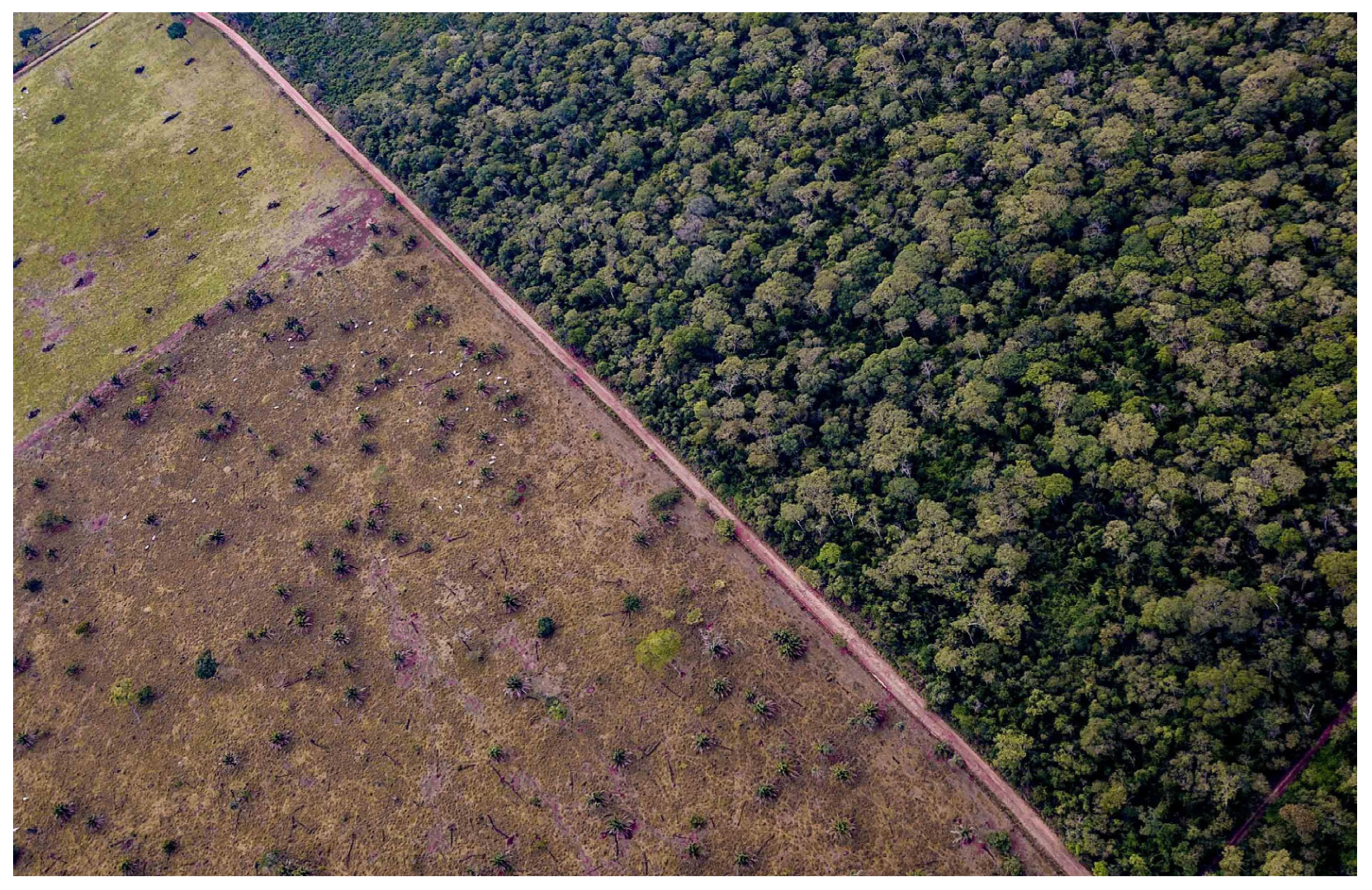

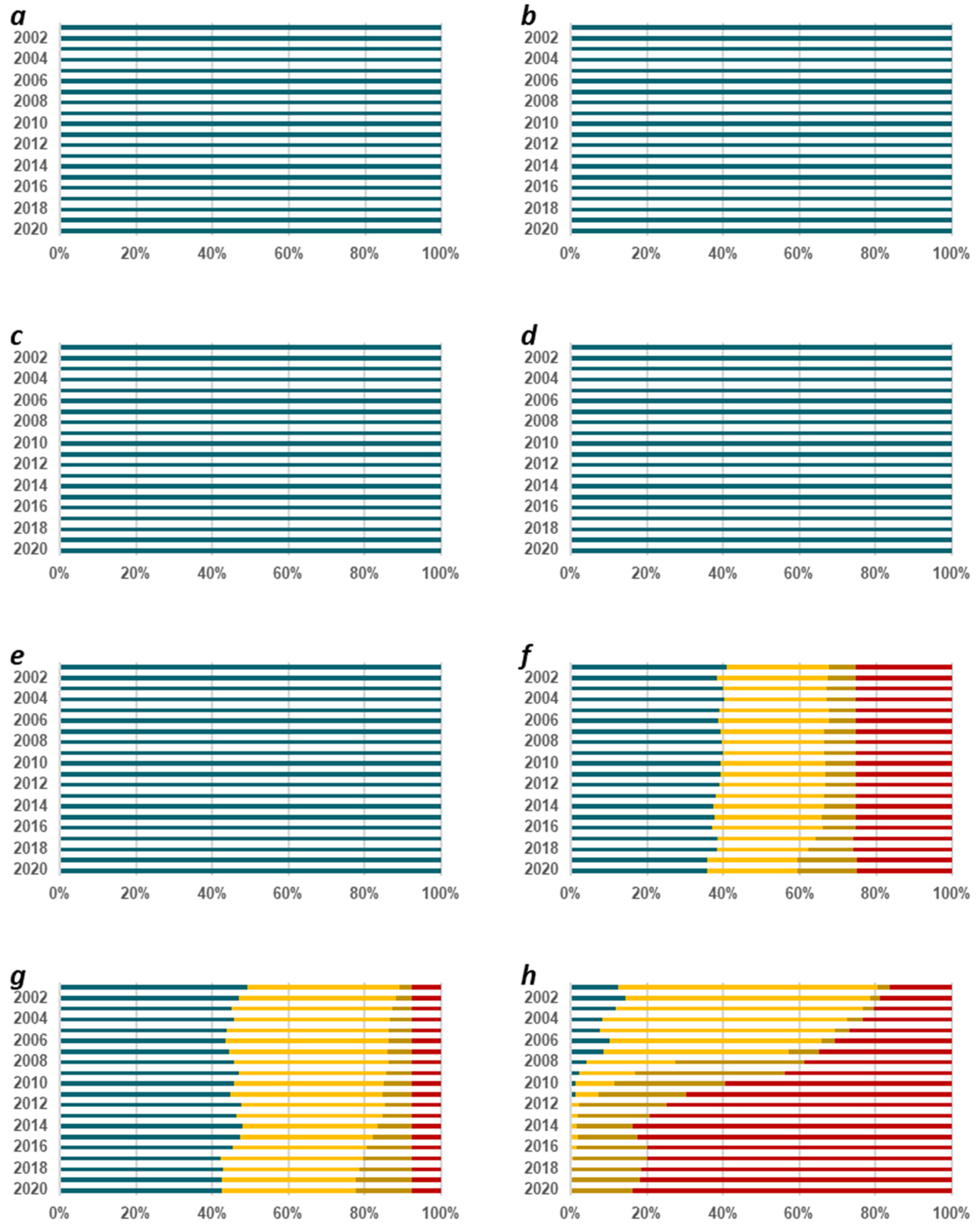
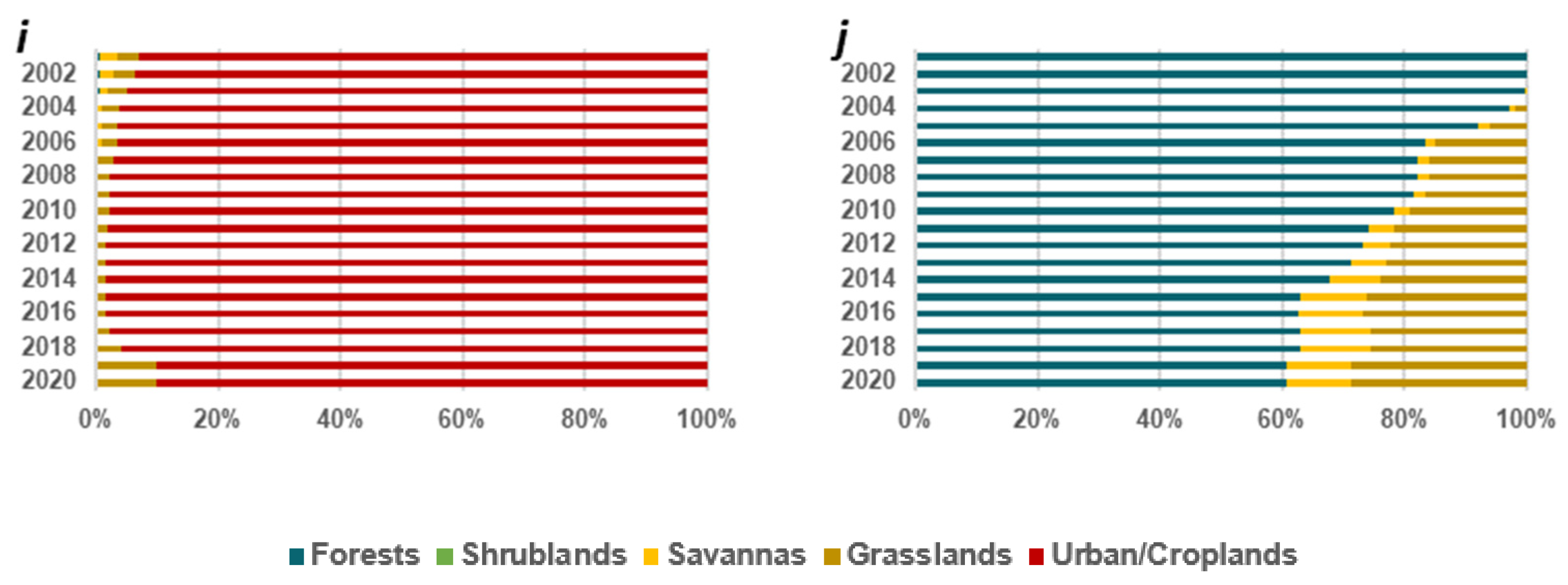
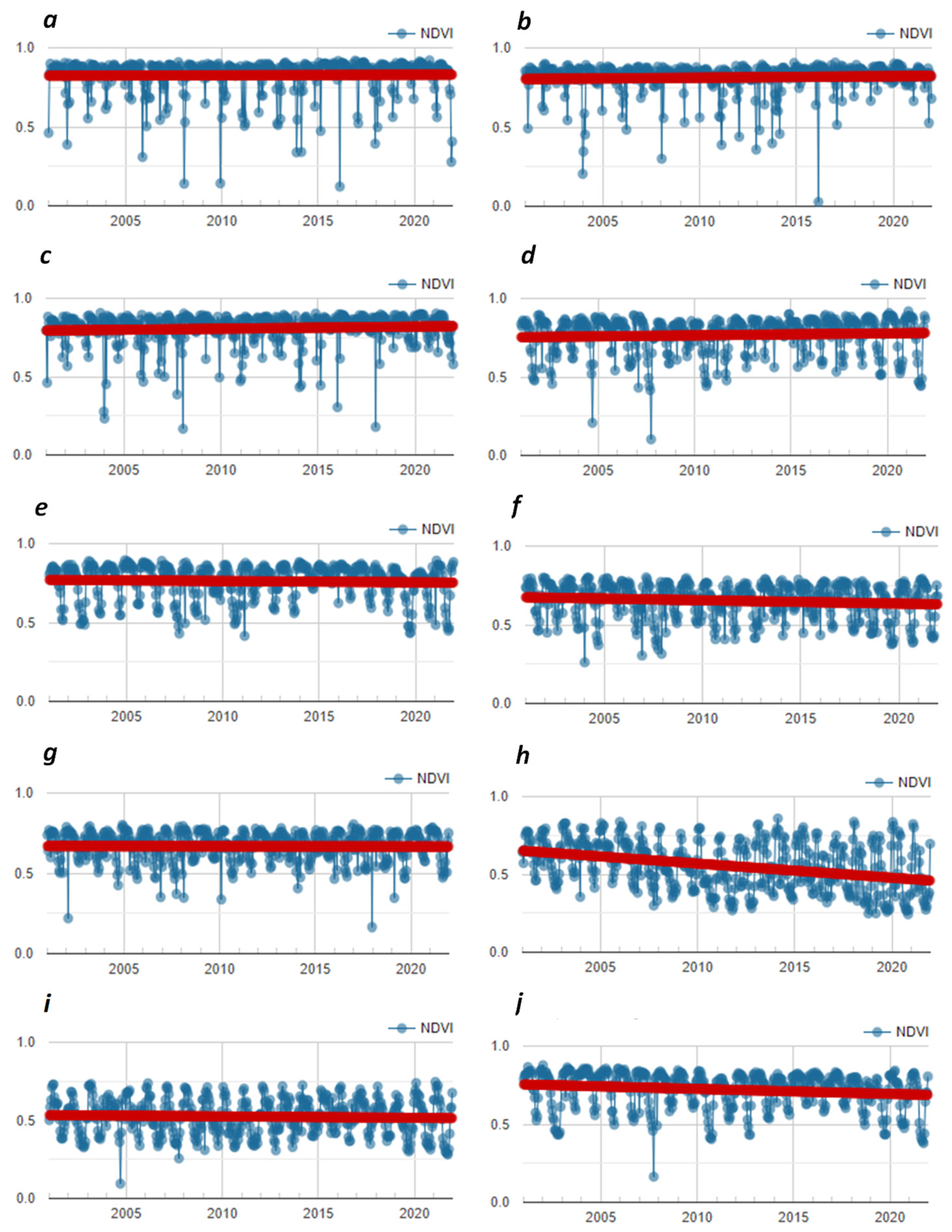
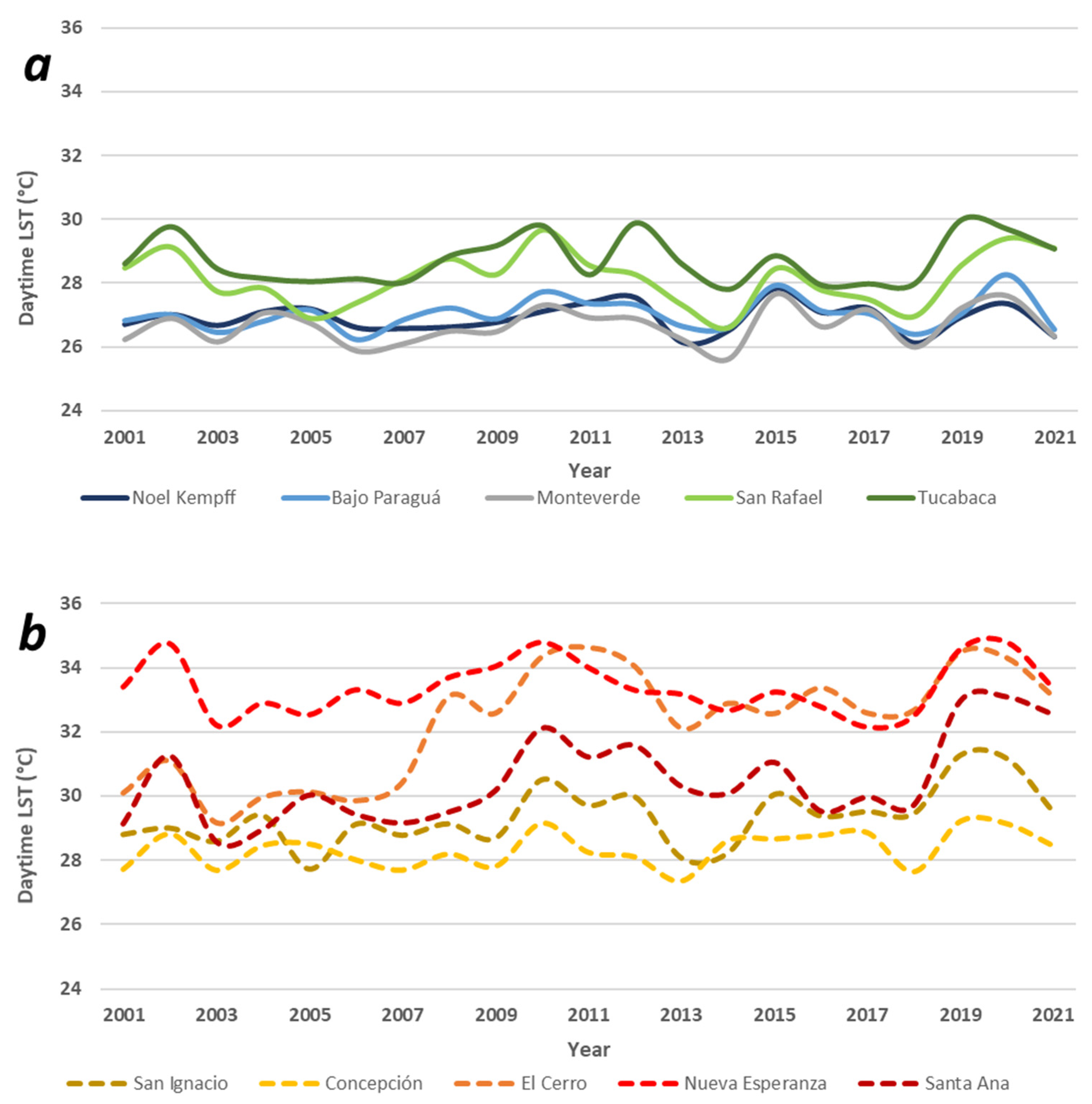

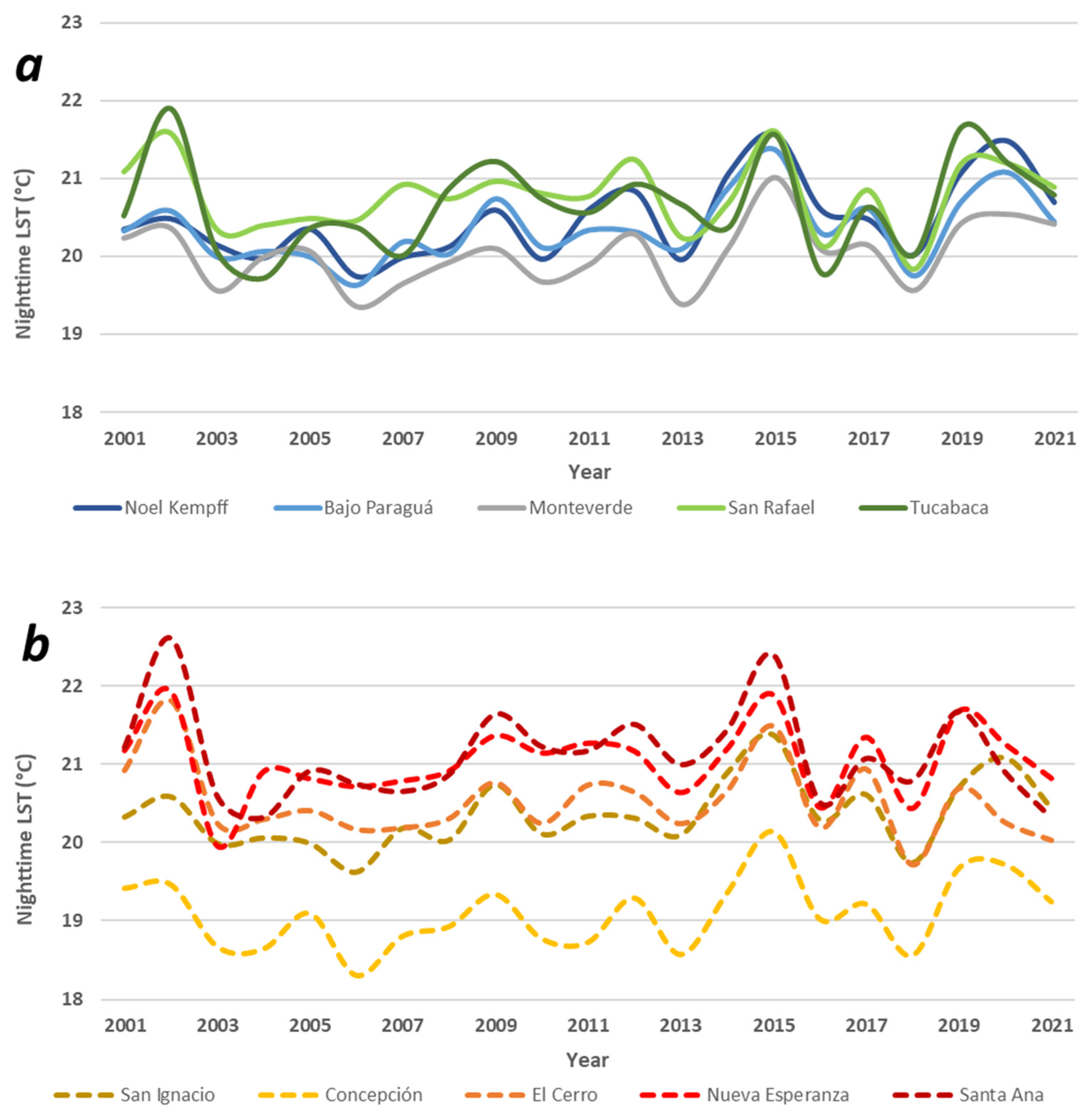
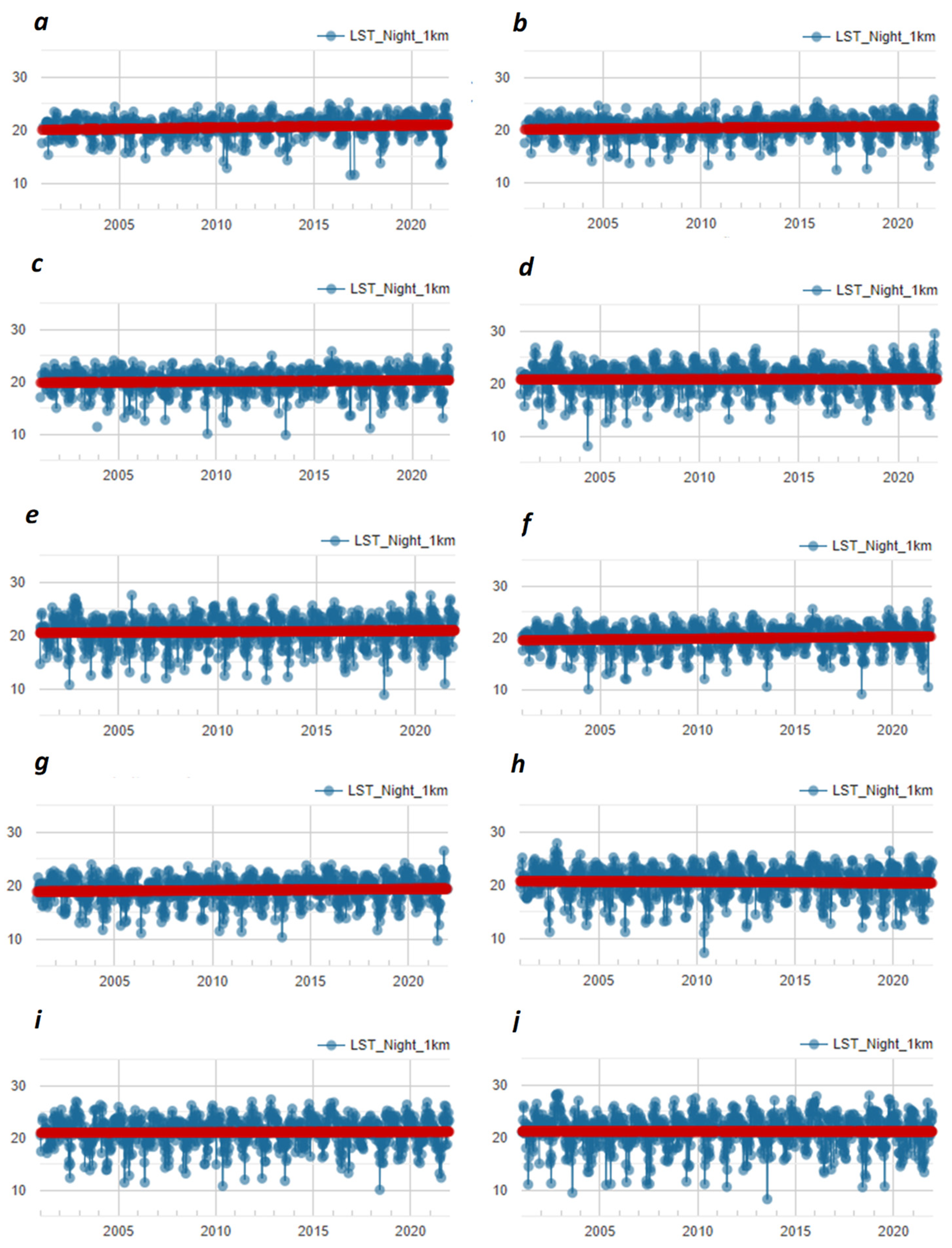
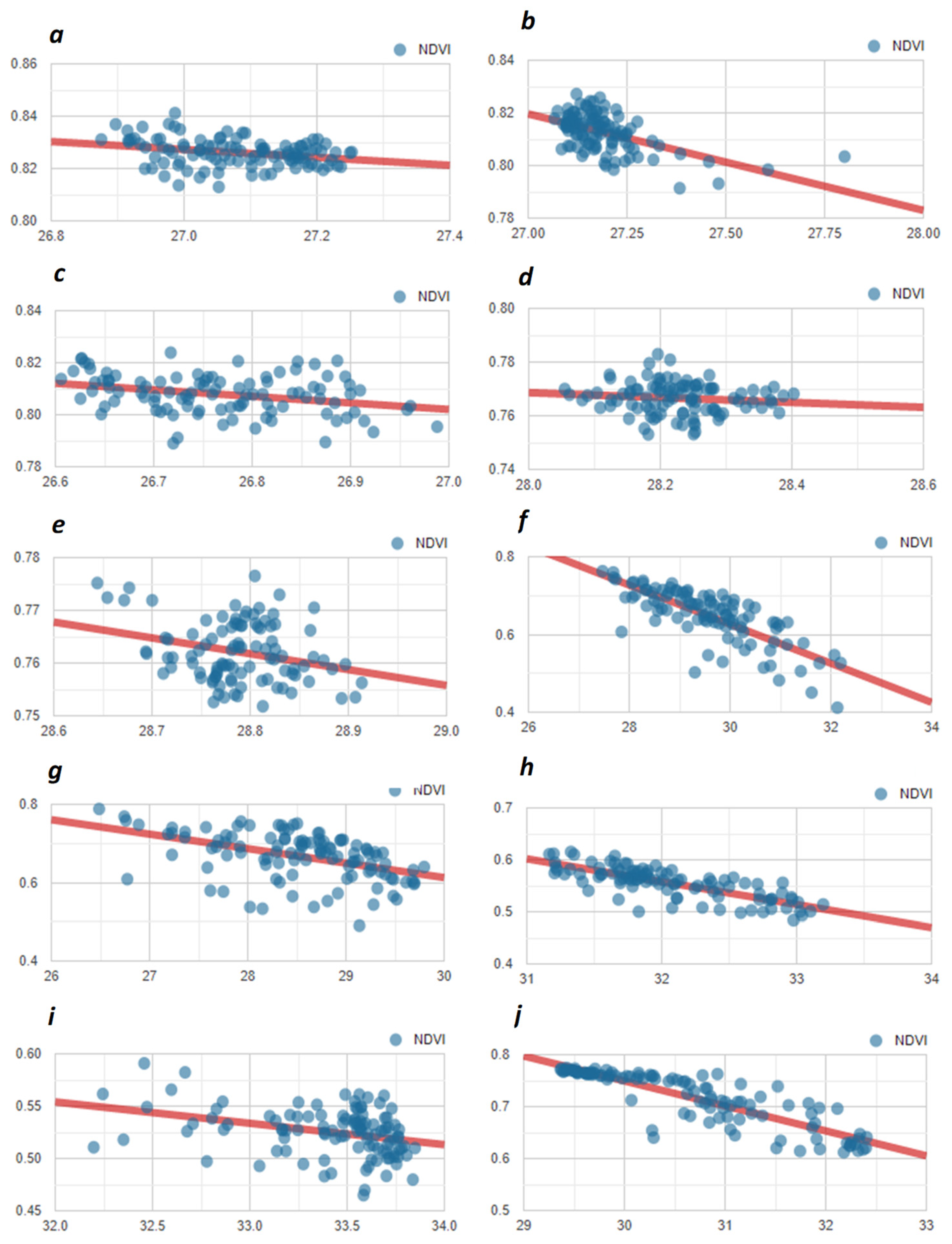
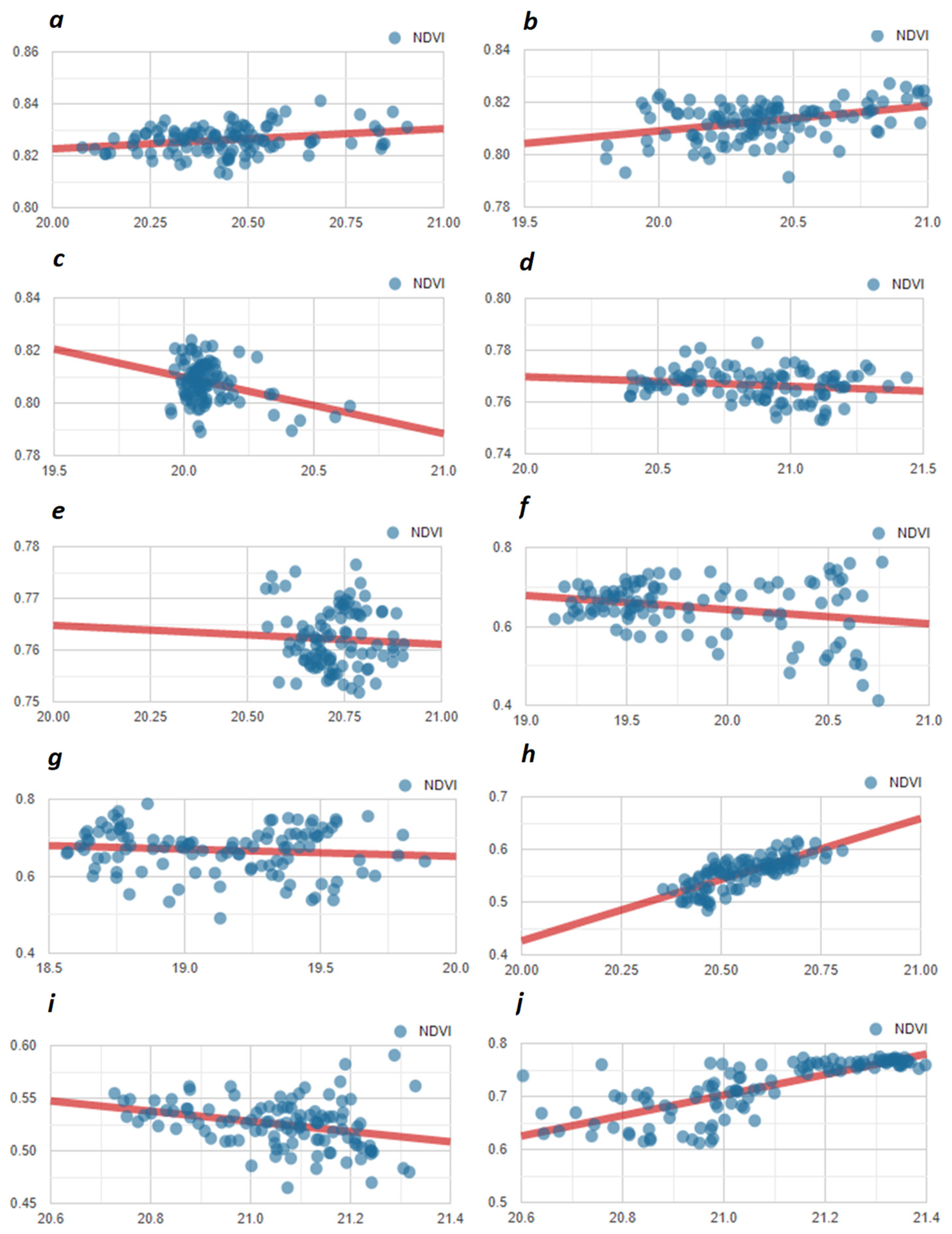
| Sites | Coverage Types | Sector | Altitude | Domain | Climate Region |
|---|---|---|---|---|---|
| Noel Kempff | Forest | North | 220–310 | National protected area | Humid |
| Bajo Paraguá | Forest | North | 210–260 | Municipal protected area | Humid |
| Monteverde | Forest | North | 260–340 | Indigenous territory | Humid |
| San Rafael | Forest | South | 240–330 | Municipal protected area | Humid |
| Tucabaca | Forest | South | 210–270 | Departmental protected area | Dry sub-humid |
| San Ignacio | Deforestation | North | 370–530 | Urban area | Humid |
| Concepción | Deforestation | North | 470–520 | Urban area | Humid |
| El Cerro/California | Deforestation | South | 252–263 | Area livestock/agricultural | Dry sub-humid |
| Nueva Esperanza | Deforestation | South | 260–310 | Area livestock/agricultural | Humid |
| Santa Ana/Buena Vista | Deforestation | South | 190–230 | Livestock area | Dry sub-humid |
| Sites | % Forest 2001 | % Forest 2021 | n | p | Z |
|---|---|---|---|---|---|
| Noel Kempff | 100 | 100 | 483 | 0.014 | 2.456 |
| Bajo Paraguá | 100 | 100 | 483 | 0.157 | 1.417 |
| Monteverde | 100 | 100 | 483 | 0.013 | 2.492 |
| San Rafael | 100 | 100 | 483 | 0.007 | 2.698 |
| Tucabaca | 100 | 100 | 483 | 0.036 | −2.094 |
| San Ignacio | 41 | 36 | 483 | 0.007 | −2.685 |
| Concepción | 49 | 43 | 483 | 0.808 | −0.243 |
| El Cerro/California | 12 | 0 | 483 | 0.000 | −8.007 |
| Nueva Esperanza | 0 | 0 | 483 | 0.308 | −1.019 |
| Santa Ana/Buena Vista | 100 | 61 | 483 | 0.000 | −5.988 |
| Sites | Coverage | n | p | Z |
|---|---|---|---|---|
| Noel Kempff | Forest | 874 | 0.412 | 0.821 |
| Bajo Paraguá | Forest | 881 | 0.089 | 1.700 |
| Monteverde | Forest | 885 | 0.124 | 1.540 |
| San Rafael | Forest | 922 | 0.438 | 0.775 |
| Tucabaca | Forest | 936 | 0.143 | 1.467 |
| San Ignacio | Deforestation | 908 | 0.000 | 45.108 |
| Concepción | Deforestation | 899 | 0.028 | 2.200 |
| El Cerro/California | Deforestation | 877 | 0.000 | 8.357 |
| Nueva Esperanza | Deforestation | 908 | 0.168 | 1.380 |
| Santa Ana/Buena Vista | Deforestation | 932 | 0.000 | 5.753 |
| Sites | Coverage | n | p | Z |
|---|---|---|---|---|
| Noel Kempff | Forest | 669 | 0.000 | 4.403 |
| Bajo Paraguá | Forest | 738 | 0.003 | 2.957 |
| Monteverde | Forest | 794 | 0.064 | 1.853 |
| San Rafael | Forest | 835 | 0.760 | −0.306 |
| Tucabaca | Forest | 878 | 0.136 | 1.493 |
| San Ignacio | Deforestation | 738 | 0.003 | 2.957 |
| Concepción | Deforestation | 848 | 0.038 | 2.070 |
| El Cerro/California | Deforestation | 887 | 0.499 | −0.677 |
| Nueva Esperanza | Deforestation | 860 | 0.445 | 0.764 |
| Santa Ana/Buena Vista | Deforestation | 898 | 0.955 | −0.056 |
| Sites | Coverage | Daytime LST-NDVI | Nighttime LST-NDVI |
|---|---|---|---|
| Noel Kempff | Forest | 0.08 | 0.07 |
| Bajo Paraguá | Forest | 0.29 | 0.15 |
| Monteverde | Forest | 0.09 | 0.11 |
| San Rafael | Forest | 0.01 | 0.03 |
| Tucabaca | Forest | 0.08 | 0.00 |
| San Ignacio | Deforestation | 0.60 | 0.15 |
| Concepción | Deforestation | 0.21 | 0.01 |
| El Cerro/California | Deforestation | 0.60 | 0.58 |
| Nueva Esperanza | Deforestation | 0.11 | 0.09 |
| Santa Ana/Buena Vista | Deforestation | 0.76 | 0.59 |
| Sites | LST (°C) | Maximum Temperature (°C) | Minimum Temperature (°C) | RMSE (°C) |
|---|---|---|---|---|
| Concepción | ||||
| Daytime LST | 1 | - | 5.4 | |
| Nighttime LST | - | 0.8 | 5.5 | |
| San Ignacio | ||||
| Daytime LST | 1 | - | 6.4 | |
| Nighttime LST | - | 0.8 | 8 |
Disclaimer/Publisher’s Note: The statements, opinions and data contained in all publications are solely those of the individual author(s) and contributor(s) and not of MDPI and/or the editor(s). MDPI and/or the editor(s) disclaim responsibility for any injury to people or property resulting from any ideas, methods, instructions or products referred to in the content. |
© 2022 by the authors. Licensee MDPI, Basel, Switzerland. This article is an open access article distributed under the terms and conditions of the Creative Commons Attribution (CC BY) license (https://creativecommons.org/licenses/by/4.0/).
Share and Cite
Maillard, O.; Vides-Almonacid, R.; Salazar, Á.; Larrea-Alcazar, D.M. Effect of Deforestation on Land Surface Temperature in the Chiquitania Region, Bolivia. Land 2023, 12, 2. https://doi.org/10.3390/land12010002
Maillard O, Vides-Almonacid R, Salazar Á, Larrea-Alcazar DM. Effect of Deforestation on Land Surface Temperature in the Chiquitania Region, Bolivia. Land. 2023; 12(1):2. https://doi.org/10.3390/land12010002
Chicago/Turabian StyleMaillard, Oswaldo, Roberto Vides-Almonacid, Álvaro Salazar, and Daniel M. Larrea-Alcazar. 2023. "Effect of Deforestation on Land Surface Temperature in the Chiquitania Region, Bolivia" Land 12, no. 1: 2. https://doi.org/10.3390/land12010002
APA StyleMaillard, O., Vides-Almonacid, R., Salazar, Á., & Larrea-Alcazar, D. M. (2023). Effect of Deforestation on Land Surface Temperature in the Chiquitania Region, Bolivia. Land, 12(1), 2. https://doi.org/10.3390/land12010002












